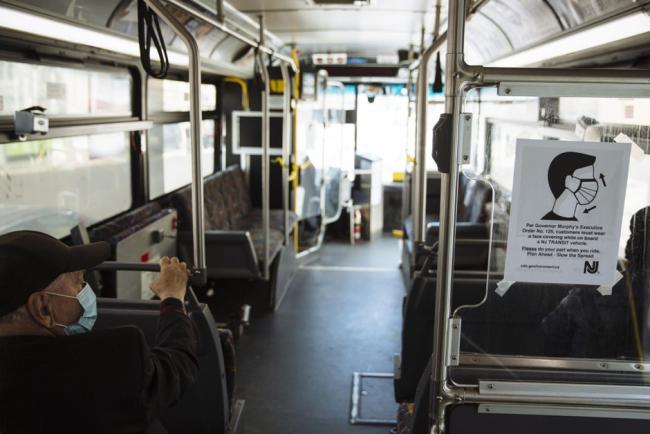Articles Menu

[Canada faces similar challenges.]
Apr. 24, 2020
Public transportation has been in a state of crisis since the coronavirus pandemic began. Ridership in major cities in the U.S., Europe and China is down by 50-90% from pre-crisis levels. Local taxes used to subsidize systems in America, such as sales taxes, have taken a big hit as well. Transit operators are running out of money quickly. While the federal government has allocated $25 billion in emergency aid to help cover operational losses, the next six months will still present an enormous financial challenge to local agencies as they struggle to attract riders back onto buses and subways and continue capital projects.
But there is a way forward. We offer these pathways for saving transit, immediately and into the future.
For the duration of the pandemic, agencies need money to continue running service, and to keep operators and passengers safe. Spending priorities need to shift and mimic the best practices used in cities that keep their public spaces clean and their infection rates low. U.S. transit agencies should do all of the following interventions:
On the operations front, agencies should also adjust schedules and consider new kinds of routes and vehicles that serve hospitals, testing centers, industrial clusters and grocery stores rather than office buildings and schools. In San Francisco, the SFMTA dramatically reduced the scope of its network by slashing 72 of 89 routes. Temporary cuts allow transit agencies to focus their workforce and resources into the routes that serve essential workers and medical centers while also maintaining enough service to permit social distancing onboard the bus.
As the economy begins to recover from the pandemic, transit agencies will have to rebuild ridership. This will be a difficult task: Historically, transit ridership and employment have been intertwined. With unemployment skyrocketing, we expect transit ridership to rebound slowly.
As agencies take a beat to figure out how they will continue to operate service beyond April, this is the perfect time for capital construction teams to consider alternatives that will reduce their construction costs and speed up timelines for future lines. The Beverly Hills City Council recently approved the full closure of a three-block stretch of Wilshire Boulevard to expedite construction on the Purple Line extension, which is projected to shave as much as six months off of the construction schedule. While rushing this work comes with its own set of health risks, if construction can continue in a safe manner, agencies should take advantage of stay-at-home orders and push for more aggressive construction timelines.
The aftermath of the 2008 financial crisis offers a lesson in what transit agencies should not do. Many agencies cut service during the ensuing recession. When we examined the change in service hours for buses in New York between 2008 and 2018, we observed that service hours had been slashed by nearly 20%, even as the unemployment rate fell from 2011-19, a time when bus service should have increased; citywide ridership fell by 22% between the same period. While this is merely a correlation — service was cut, ridership fell — there is evidence of causation in the transportation literature.
That’s why short-term cuts deployed to save transit agencies money during a crisis should not become permanent once the crisis is over. Transit agency after transit agency made this same mistake after 2008 and saw ridership decline year after year, except Seattle, which increased service and experienced ridership gains.
Finally, in the long run, the federal government should work with states to relax local land-use restrictions and nurture a more beneficial transportation-land-use connection. Transit thrives when it is surrounded by a certain level of population density and mix of land uses; because American cities are largely defined by low-density development, many cities with fairly expansive subway and light-rail networks have flagging ridership. If land-use regulations around train stations allowed a greater mix of mid- and high-rise buildings, they’ll attract higher ridership than if they continue to be flanked by single-family houses (as in much of California) or parking lots (as in many newer American light rail networks).
Transit agencies need the funding they are about to receive, but it will hardly solve all of their problems. For starters, the way the federal government apportions money to transit agencies often comes in the form of competitive grants for capital projects, such as a new light-rail or the extension of a legacy subway network. This $25 billion emergency infusion, however, is exclusively for operational costs, the provision of service. While we hope that Covid-19 is a blip on the radar, this shift in funding priorities is an extremely encouraging development that we hope takes shape in future programs that fund state-of-good-repair maintenance.
As transit agencies struggle to find their footing in an uncertain future with dramatically less revenue from the usual sources, it’s time to rethink how transit agencies operate and are funded. If agencies reassess their priorities and push forward ambitious plans to reorient cities around their systems, with the assistance of the federal government, buses and subways can thrive when the country is ready to return to regular service.
Based in Paris, Alon Levy has written about public transit and urbanism at Pedestrian Observations since 2011.
Eric Goldwyn is a research scholar at New York University’s Marron Institute and an affiliated faculty fellow at NYU Shanghai. His writing on cities has previously appeared in New York magazine and the New Yorker online.
[Top photo: A sign advising passengers to wear face masks is displayed on a New Jersey Transit bus in Atlantic City. Angus Mordant/Bloomberg]